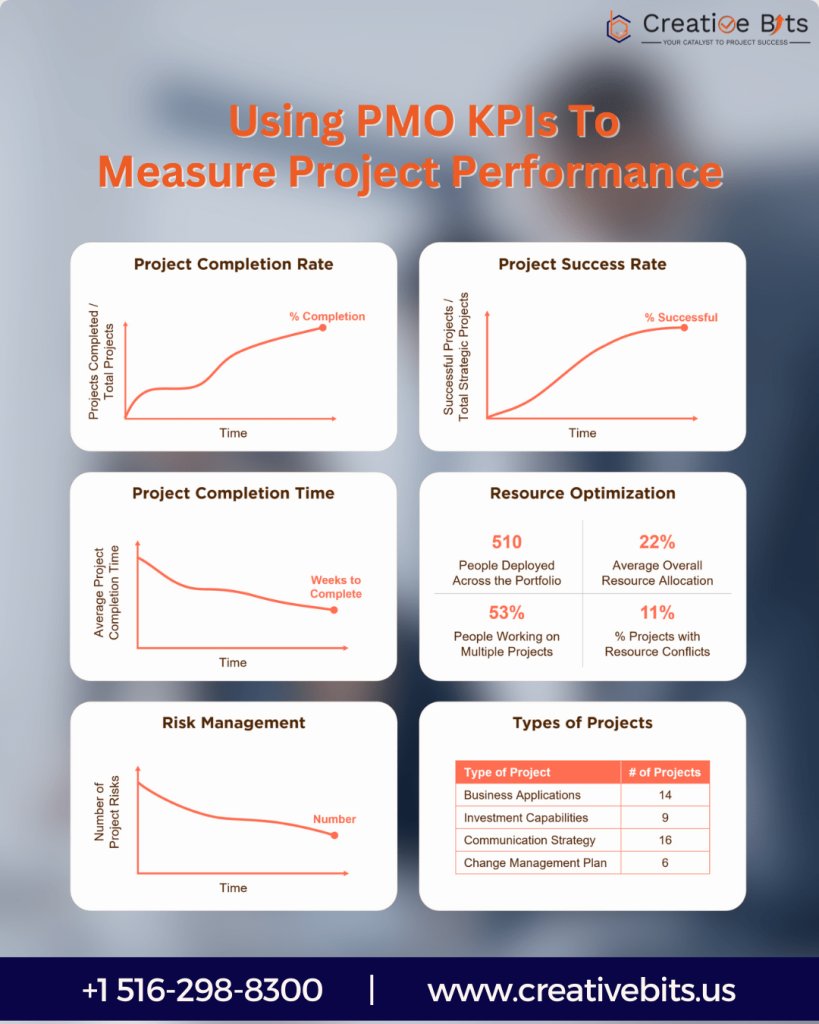Measuring performance accurately and consistently is crucial for the success of any organization. Project Management Offices (PMOs) play a vital role in this effort by providing a structured approach to governance, risk management, and performance tracking.
To achieve this, PMOs rely on Key Performance Indicators (KPIs) that offer actionable insights into project performance and alignment with broader organizational goals.
What Are PMO KPIs?
PMO KPIs are specific metrics designed to measure the performance, efficiency, and effectiveness of a PMO's activities. These indicators are crucial for ensuring that projects stay on track, within scope, on budget, and aligned with strategic objectives. By monitoring the right KPIs, PMOs can provide data-driven insights that help decision-makers identify trends, forecast outcomes, and implement corrective measures when necessary.
Categories of PMO KPIs
1. Efficiency KPIs: These KPIs focus on how well resources are being utilized within a project. Examples include project delivery times, budget adherence, and resource allocation efficiency.
2. Effectiveness KPIs: These KPIs measure the extent to which the PMO achieves its intended outcomes. This includes project success rates, stakeholder satisfaction, and goal alignment with business objectives.
3. Quality KPIs: These indicators focus on the quality of deliverables and how closely they meet predefined standards or client expectations. Common examples are defect rates, error margins, and customer feedback.
4. Risk Management KPIs: Assessing the PMO's ability to manage project risks is crucial. Risk-related KPIs may include the frequency of risk occurrence, mitigation success rates, and the time to respond to risk events.
5. Financial KPIs: These indicators measure the financial health of the PMO and its projects. This could include budget variance, return on investment (ROI), and cost performance index (CPI).
Why Are PMO KPIs Important?
Alignment with Strategic Objectives
PMO KPIs help ensure that projects are aligned with the organization’s strategic objectives. By tracking KPIs such as goal completion rates and project portfolio performance, the PMO can ensure that resources are focused on initiatives that directly contribute to business growth and competitiveness.
Improved Decision-Making
With real-time performance data, PMO leaders can make more informed decisions. KPIs act as a guiding light, allowing leaders to spot potential issues early and take corrective action to keep projects on track. For instance, if budget adherence is consistently poor across projects, it might indicate a need for better financial management practices.
Increased Accountability
Tracking PMO KPIs fosters accountability among project teams and stakeholders. When everyone knows what metrics are being monitored and how performance is being evaluated, it increases the sense of responsibility across all levels of the organization.
Key PMO KPIs to Measure for Performance Success
1. Project Delivery Timeliness
One of the most critical PMO KPIs is the timeliness of project delivery. This metric tracks whether projects are completed within the set deadlines. Missed deadlines can lead to budget overruns, dissatisfied stakeholders, and missed business opportunities. Monitoring the average time to completion for projects can reveal bottlenecks and inefficiencies that need addressing.
2. Budget Variance
Budget variance is a financial KPI that measures the difference between planned and actual project expenditures. A low budget variance indicates that the PMO is effective in financial management, whereas a high variance could signal the need for more stringent budgeting practices or better cost estimation during the project planning phase.
3. Resource Utilization
Resource utilization measures how effectively project resources (personnel, tools, and time) are being used. Overutilized resources can lead to burnout and decreased productivity, while underutilized resources represent wasted potential. Striking the right balance is essential for long-term project success.
4. Customer Satisfaction
This KPI assesses how well the deliverables meet the expectations of the end users or stakeholders. This is often measured through surveys or feedback forms. A high level of customer satisfaction is a strong indicator that the PMO is delivering value.
5. Project Success Rate
The project success rate is a fundamental KPI that measures the percentage of projects that are completed on time, within budget, and meet the agreed-upon objectives. A high project success rate reflects the PMO’s effectiveness in managing scope, timelines, and resources.
6. Risk Resolution Efficiency
Risk is an inherent part of any project, and how well the PMO manages risk can make or break a project’s success. This KPI tracks how quickly risks are identified, assessed, and mitigated. By improving risk resolution times, the PMO can reduce the likelihood of risks derailing projects.
7. Change Request Frequency
Frequent change requests can be an indicator of poor planning or shifting project scopes. Monitoring the frequency of change requests allows the PMO to identify patterns and address the root causes of scope changes, improving overall project predictability and control.

See also: Project Management as a Service (PMaaS): The Future of Project Delivery
Best Practices for Implementing PMO KPIs
1. Choose Relevant KPIs
Not all KPIs will be relevant to every organization. It’s essential to select KPIs that align with your specific strategic goals and business context. For instance, a tech startup might prioritize innovation-related KPIs, while a government agency might focus more on regulatory compliance and risk management.
2. Set Realistic Targets
KPIs are only useful if they have clear, realistic targets that the PMO can work towards. It’s critical to set benchmarks that are ambitious yet achievable, ensuring that teams are motivated to improve without setting them up for failure.
3. Monitor and Adjust KPIs Regularly
Business environments are dynamic, and KPIs should be flexible enough to adapt to these changes. Regularly review and adjust KPIs to ensure they remain aligned with current business priorities and project realities.
4. Use Tools for KPI Tracking
Leveraging project management tools with integrated KPI tracking features can streamline the process. These tools provide real-time dashboards, automatic reporting, and data visualization, helping PMOs make timely and informed decisions.
Read more on: Choosing the Right Project Management Software
KPIs are Vital – Don't Neglect Them
PMO KPIs are essential for driving performance and ensuring project success. By selecting the right KPIs and continuously monitoring them, organizations can ensure that their PMOs provide the necessary oversight, accountability, and data-driven insights to keep projects aligned with strategic goals.
Ready to enhance your project management processes and drive success with data-driven insights? Contact us today to learn how we can help you set up and optimize your PMO with tailored KPIs and expert solutions. Let’s ensure your projects stay on track and aligned with your strategic goals!

 monday.com Services
monday.com Services
